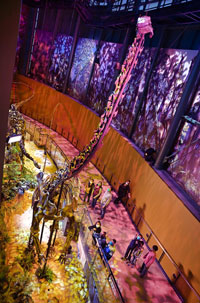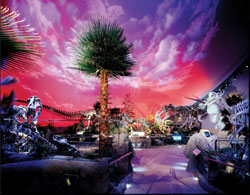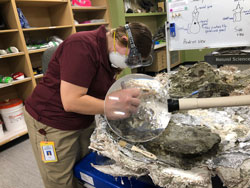FOR IMMEDIATE RELEASE
Opening: March 19, 2022
 Imagine life 150 million years ago. The Earth shook with each footstep by massive dinosaurs (stretching 60–80 feet, nose to tail) as they pounded the ground and searched for plants to satisfy their huge appetites. Listen for the pitter-patter of smaller creatures racing for cover as theropods scavenged the area for their next meal. Hear the splashing and gurgling of ocean waves as you discover a treasure trove of marine life, from massive monsters to miniature shellfish. With each step into the NEW Dinosphere: Now You’re in Their World® at The Children’s Museum of Indianapolis, children and families come face-to-face—and in some cases, face-to-knee—with magnificent dinosaurs and marine reptiles that once dominated the world.
Imagine life 150 million years ago. The Earth shook with each footstep by massive dinosaurs (stretching 60–80 feet, nose to tail) as they pounded the ground and searched for plants to satisfy their huge appetites. Listen for the pitter-patter of smaller creatures racing for cover as theropods scavenged the area for their next meal. Hear the splashing and gurgling of ocean waves as you discover a treasure trove of marine life, from massive monsters to miniature shellfish. With each step into the NEW Dinosphere: Now You’re in Their World® at The Children’s Museum of Indianapolis, children and families come face-to-face—and in some cases, face-to-knee—with magnificent dinosaurs and marine reptiles that once dominated the world.
Visitors are fully immersed in a time long ago with magnificent sound and light shows, actor interpreter performances and gallery interpreters who answer questions visitors didn’t even know they had.
The museum brought in amazing new dinosaurs, including Giants of the Jurassic™ and Monsters of the Mesozoic Seas™, which will join longtime favorites in Creatures of the Cretaceous™ to create this extraordinary new exhibit. Along with international partners from the Naturalis Biodiversity Center (Netherlands) and the University of Manchester (United Kingdom), paleontologists from The Children’s Museum unearthed some of these fossils from its dig site in Wyoming known as the Jurassic Mile™.
 “If I hadn’t seen it with my own eyes, I’m not sure I’d believe it,” said Jennifer Pace Robinson, president and CEO, The Children’s Museum of Indianapolis. “The Jurassic Mile site is extremely unique because it is a fossil-rich plot of land that contains hundreds of bones as well as footprints or trackways that tell us more about the behavior of dinosaurs. Not only that, it contains fossilized plants that help us better understand the environment—all alongside an ancient seabed. To have everything in one place helps us paint a more complete picture of what that point in time really looked like, and it helps us bring real science to life for our visitors.”
“If I hadn’t seen it with my own eyes, I’m not sure I’d believe it,” said Jennifer Pace Robinson, president and CEO, The Children’s Museum of Indianapolis. “The Jurassic Mile site is extremely unique because it is a fossil-rich plot of land that contains hundreds of bones as well as footprints or trackways that tell us more about the behavior of dinosaurs. Not only that, it contains fossilized plants that help us better understand the environment—all alongside an ancient seabed. To have everything in one place helps us paint a more complete picture of what that point in time really looked like, and it helps us bring real science to life for our visitors.”
“Rather than a story, I think of the fossil record as a giant library,” said Dr. Phil Manning, Extraordinary Scientist-in-Residence, The Children’s Museum of Indianapolis. “As you enter the library, the new and most recent books are shiny and complete on the shelves, as you push deeper into the library, and time, the books start to get a little tatty—missing key bits of information. By the time you are in the abyss that is geological time (the age of dinosaurs,) only the occasional word or paragraph sit on the fossil record library shelves. It is from these disjointed sentences—fossils—that we are able to reconstruct the lost world of the Jurassic.”
Giants of the Jurassic™
 Visitors will have to crane their necks way back to see the top of the first giant sauropod, which is posed as though it is rearing up on its hindquarters. It is followed by another sauropod that seems to be grazing behind it. An equally compelling find from the dig site that visitors will learn about is the discovery of hundreds of theropod teeth. “There are a couple hypotheses for why we found so many theropod teeth. One is [that] this was a large animal—making quite the smorgasbord for other animals to find out on the Plains,” said Dr. Jenn Anné, Lead Paleontologist, The Children’s Museum. “So a couple of theropods could chomp down on it and have enough space between them that they didn’t have to fight over it. Another hypothesis could be that this animal laid there for a fairly long period of time. Multiple individuals came up and took a nibble over time. It could also be that some of the teeth could have washed in from other areas.”
Visitors will have to crane their necks way back to see the top of the first giant sauropod, which is posed as though it is rearing up on its hindquarters. It is followed by another sauropod that seems to be grazing behind it. An equally compelling find from the dig site that visitors will learn about is the discovery of hundreds of theropod teeth. “There are a couple hypotheses for why we found so many theropod teeth. One is [that] this was a large animal—making quite the smorgasbord for other animals to find out on the Plains,” said Dr. Jenn Anné, Lead Paleontologist, The Children’s Museum. “So a couple of theropods could chomp down on it and have enough space between them that they didn’t have to fight over it. Another hypothesis could be that this animal laid there for a fairly long period of time. Multiple individuals came up and took a nibble over time. It could also be that some of the teeth could have washed in from other areas.”
“During this time period, there were no flowering plants,” said Dr. Victoria Egerton, Eli Lilly and Company Extraordinary Scientist-in-Residence, The Children’s Museum of Indianapolis. “That means there were no fruits, no vegetables, no grass for the herbivores. So these enormous dinosaurs—the largest animals ever to walk on our Earth—were eating things like conifers and ferns and horsetails—things that we don't really eat today, but that allowed them to get enough nutrients to grow into enormous sizes. Learning about these plants may help us learn about something else that we could potentially eat, or a different resource that maybe we should start to consider for nutrition.”
And then there are the trackways that tell you more about the animals’ movement and behavior. “When you find a fossil footprint, nothing is more exciting than finding the next footfall in the same trackway. You are then truly ‘walking with dinosaurs,’” said Manning. These footprints serve as a reminder that these were living things.
Monsters of the Mesozoic Seas™
 The atmosphere of this ocean-themed section makes families feel like they are swimming beneath the waves alongside a sea creature reminiscent of the Loch Ness Monster. The Elasmosaurus, with its with sharp, pointy, fang-like teeth and 23-foot-long neck, is posed to look like it is plunging into the water alongside visitors. A 20-foot-long Baptanodon had freakishly large eye sockets the size of dinner plates. The Sundance Sea, where Baptanodon once lived, wasn’t deep enough to get very dark, so its enormous eyes were likely most useful for hunting prey at night. The Plioplatecarpus (a type of mosasaur) was one of the top predators in the ocean. They ate just about anything they could catch, including other mosasaurs. They used their double-hinged jaws and flexible skulls to open their mouths wide.
The atmosphere of this ocean-themed section makes families feel like they are swimming beneath the waves alongside a sea creature reminiscent of the Loch Ness Monster. The Elasmosaurus, with its with sharp, pointy, fang-like teeth and 23-foot-long neck, is posed to look like it is plunging into the water alongside visitors. A 20-foot-long Baptanodon had freakishly large eye sockets the size of dinner plates. The Sundance Sea, where Baptanodon once lived, wasn’t deep enough to get very dark, so its enormous eyes were likely most useful for hunting prey at night. The Plioplatecarpus (a type of mosasaur) was one of the top predators in the ocean. They ate just about anything they could catch, including other mosasaurs. They used their double-hinged jaws and flexible skulls to open their mouths wide.
Creatures of the Cretaceous™
 Creatures of the Cretaceous™ features dinosaurs that visitors to The Children’s Museum have come to know and love, including a couple of T. rex, a Gorgosaurus, and a mummified duckbill dinosaur. The former Cinedome sets the perfect stage with a brilliantly colored sky that transitions from dawn to dusk to midnight (with meteor showers,) immersing families in the sights and sounds of the Cretaceous. Dracorex hogwartsia will remain on Level 2 by the main elevators.
Creatures of the Cretaceous™ features dinosaurs that visitors to The Children’s Museum have come to know and love, including a couple of T. rex, a Gorgosaurus, and a mummified duckbill dinosaur. The former Cinedome sets the perfect stage with a brilliantly colored sky that transitions from dawn to dusk to midnight (with meteor showers,) immersing families in the sights and sounds of the Cretaceous. Dracorex hogwartsia will remain on Level 2 by the main elevators.
Paleo Prep Labs
 The museum’s scientists continue to work in the R.B. Annis Mission Jurassic Paleo Prep Lab and the Polly H. Hix Paleo Prep Lab, preparing fossils they brought back from the Jurassic Mile™ dig site. Visitors can watch them saw open giant field jackets that weigh 1–2 tons in one lab or put together the teeny tiny pieces of a fossil puzzle in the other lab. Our scientists enjoy answering questions about the bones and what different markings might mean.
The museum’s scientists continue to work in the R.B. Annis Mission Jurassic Paleo Prep Lab and the Polly H. Hix Paleo Prep Lab, preparing fossils they brought back from the Jurassic Mile™ dig site. Visitors can watch them saw open giant field jackets that weigh 1–2 tons in one lab or put together the teeny tiny pieces of a fossil puzzle in the other lab. Our scientists enjoy answering questions about the bones and what different markings might mean.
Dinosphere Art Lab
Paleo art combines science and art to bring life to the everyday activities of dinosaurs. This area will help spark creativity and ignite imaginative play as visitors are invited to design their own dinosaur and scan the drawing. Then, they watch as their animated dino “hatches” from an egg and virtually joins other dinosaurs roaming the Earth on a giant projection screen. Trace a dinosaur trackway or feel two sides of a diplodocid sculpture (one fleshed out with scales and the detailing its bone structure). Or simply be inspired by the paintings, sculptures and comics on display.
Dinosphere® is made possible through lead gift support from Lilly Endowment Inc., The Scott A. Jones Foundation, Eli Lilly and Company Foundation, The Enid Goodrich Educational Initiatives Fund of The Children’s Museum, Polly H. Hix, Yvonne H. Shaheen, The Elliott Sogard Family, and Bob and Carol Reynolds, with major support provided by The R.B. Annis Educational Foundation, Bowen Engineering Corporation, The Dan and Rhonda Hall Family, and Seymour and Rheta Holt. The Children’s Museum of Indianapolis is proud to partner with Riley Children’s at Indiana University Health, Old National Bank and Ice Miller LLP.
About The Children's Museum of Indianapolis
The Children's Museum of Indianapolis is a nonprofit institution committed to creating extraordinary learning experiences across the arts, sciences, and humanities that have the power to transform the lives of children and families. For more information about The Children's Museum, visit www.childrensmuseum.org, follow us on Twitter @TCMIndy, Instagram@childrensmuseum, YouTube.com/IndyTCM, and Facebook.

 (
(











